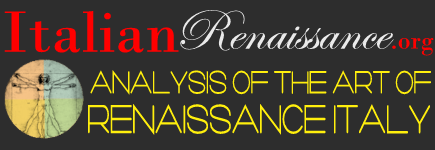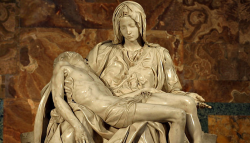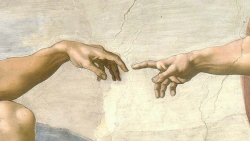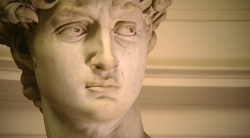The names of artists and architects of many medieval works have frequently been forgotten by history. During the Middle Ages, the creators of art were not as important as the art itself; today, medieval works are often times listed as anonymous creations rather than creations of specific people. This started changing around the time of the Renaissance, when the identity of the artist or architect became a more important component of the work itself. We start to see more and more works given attribution by scholars and historians during the Renaissance, and we are also told more stories about the lives of the artists. In effect, the status of the Renaissance artist rose to a level which was far greater than anything he had enjoyed in the Middle Ages. One of the reasons for this was undoubtedly the general humanist belief in the capacity of the individual to achieve great things. If an individual’s talent in sculpting marble, or his genius in constructing a building, meant that he rose above his contemporaries, why shouldn’t that be praised and commended during his lifetime? This elevation of the status of artist or architect, rather than just that of what he created, is one of the significant shifts that separates the Renaissance from the Middle Ages.
The list of Renaissance figures below is an overview of the major figures in Italian art and life. It is not an exhaustive list, but covers the most important figures who shaped the Renaissance.
Note – some dates are approximate
Lorenzo Ghiberti (1378-1455)
Filippo Brunelleschi (1377-1446): a sculptor and architect who played a part in some of the most important events in Quattrocento Florence. Giving up sculpture after losing the competition to create the bronze door panels for the Baptistery of San Giovanni in Florence (1401-1402), Brunelleschi went on to design the single most important architectural feature of Florence – the dome covering the cathedral (1420-1436). Further, his work on one-point linear perspective would have a profound impact on the course of painters of the Renaissance.
Donatello (c. 1386-1466): worked with a variety of materials, such as marble, bronze, wood, stucco reliefs, and glass. Donatello and Brunelleschi went to Rome together at one point, where the former saw the ancient sculpture and architecture which would have an impact on his subsequent work. He brought classical influences into his sculpture but did not copy exactly from ancient sources, and he is noted for bringing different classical and perspectival devices to Renaissance art.
Fra Angelico
Michelozzo di Bartolomeo Michelozzi (1396-1472)
Masaccio (1401-1428)
Leon Battista Alberti (1404-1472)
Fra Filippo Lippi
Pietro Perugino
Sandro Botticelli (1445-1510): known for painting for the powerful Medici family, Botticelli produced some of the most recognizable humanist-inspired paintings of the Quattrocento.
Donato Bramante (1444-1514)
Leonardo da Vinci (1452-1519)
Raphael Sanzio
Michelangelo Buonarroti (1475-1564)
Giovanni Bellini (1430-1516)
Giorgione (1477-1510)
Titian (c. 1488-1576): the most important painter of Venice during the sixteenth century, Titian’s career spanned eight centuries. He painted a variety of subject matters, from devotional images to large altarpieces, to portraits to mythological scenes, almost always using oil on canvas. He worked for some of the most powerful figures in Europe at the time, such as the Duke of Mantua (Alfonso d’Este), Pope Paul III and his nephew Cardinal Alessandro Farnese, and the rulers of Spain, Charles V and his son Philip II. Although he was the most famous painter in all of Europe at the time of his death, he worked primarily from his studio in Venice.
Jacopo da Pontormo (1494-1557)
Andrea Palladio (1508-1580): He was the most important architect in Venice in the second half of the sixteenth century. He was an important designer of villas in the Veneto region before turning to Venice itself, where he combined classically-derived principles with innovation in religious architecture. His approach to architecture would spawn an entire architectural movement in eighteenth-century England, known as “Palladianism” (or the “Palladian Revival”), which would drive the design of some of the largest mansions of the period.
Tintoretto (1518-1594)
Giambologna (1529-1608)



